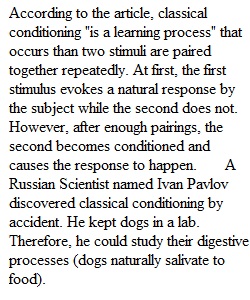


Q Please answer 5 out of the 6 questions below: 1. Define learning and behavior according to learning theories (i.e., behaviorism). 2. Define and illustrate classical conditioning 3. Define operant conditioning, including reinforcement and punishment. Provide an illustration of each. 4. Explain Chomsky's argument that Skinner's notions of stimulus and reinforcer cannot be objectively defined, that is, a stimulus and a reinforcer always depend on subjective (i.e., mental) processes. 5. Define latent learning and explain how Tolman's experiment demonstrated that learning takes place in the absence of rewards. In others, explain how Tolman's research disavowed (went against and disproved) the notion that learning must be motivated by extrinsic factors (i.e., external rewards) and instead can be intrinsically motivated. 6. Explain Rom Harre's critique of Skinner's book 'Walden two' as authoritarian. What's the learning paradox in Skinner's approach? (See 'The Behaviorists pg. 18).
View Related Questions